2023 CANADIAN ELECTRONICS INDUSTRY REPORT
North American & International Cords for Every Time Zone

Our apologies to world travelers everywhere: our cords tend to ignore the International Date Line. Whether Taiwan, Tonga, or Tulsa bound, our cords aren’t clock-watchers. Made in the U.S.A., our North American and international cord sets provide correct country-specific amperages and voltages ensuring customers everywhere have access to their local mains power.
Interpower cords, cord sets, plugs, and components ship the same day if in stock! All Interpower cords and components are manufactured in accordance with Interpower’s product quality plan: hipot testing, continuity testing, and ground testing.
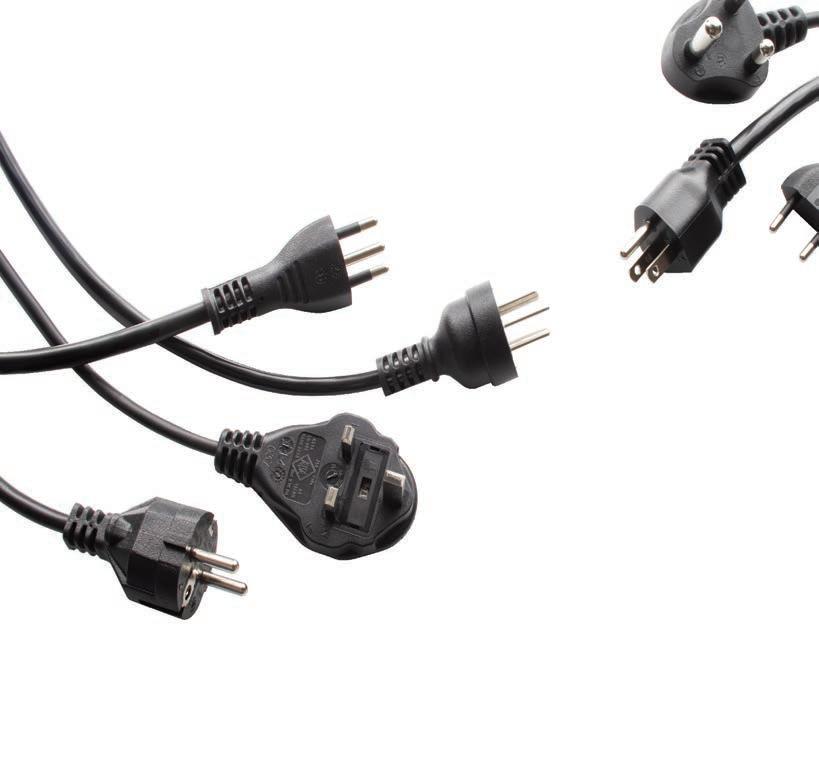
An in depth look at the state of Canada’s electronics industry
Delivering more
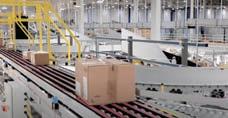
and

View Mouser’s state-of-the-art facility at mou.sr/modern-facility
● One source for your BOM - Mouser offers the world’s widest selection of electronic components ● Stocking 100% fully traceable products from over 1,200 authorized, industry-leading manufacturer partners ● Host to an extensive library of technical resources including articles, blogs, videos, infographics
more for the design engineer ● Equipped state-of-the-art automation from Mouser’s 1 million sq. ft. global distribution center - delivering more to our customers across the globe

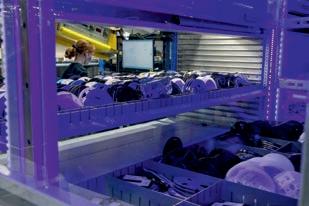
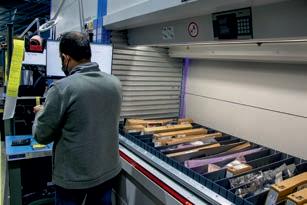



mouser.com
MESSAGE FROM MOUSER ELECTRONICS
It is still an incredible time to be the electronics business! During the past months, each of us has had far too many conversations about the challenges that ‘NOW’ has brought our way. All the extra hours we spent on how to navigate Covid protocols in 2020 and 2021 have now been replaced with time spent on supply chain aerobics and staffing discussions – trying to take the available parts and people and prepare ourselves to witness true “loaves and fishes” miracles. It’s certainly never boring.
A s things continue to improve on the supply side, Mouser has been working hard to add additional staff in our Canada office, corporate office in Texas, and in our office support teams in Bangalore, India. Mouser now has more than 2,700 employees worldwide to help get the latest tech into engineer’s hands. Currently, Mouser is a globally authorized distributor for over 1,200 industry-leading semiconductor and electronic component manufacturer brands. Despite all the challenges of the last few years, we continue to specialize in the rapid introduction of the newest products and technologies targeting the design engineer and buyer communities.
M ouser has 27 offices located around the globe. We conduct business in 21 different languages and 34 currencies. Our global distribution center is equipped with state-of-the-art wireless warehouse management systems that enable us to process orders 24/7, and deliver nearly perfect pick-and-ship operations.
A s you’ll see in this year’s report (and I’ve heard from many customers), attraction and retention of staff has been a key challenge. Our industry certainly isn’t unique – most industries will have this at the top of their list of challenges as well. Many companies in our industry have added lots of new staff to their purchasing teams to help keep up with the additional tasks this season has brought. Some of these folks had experience and others had to pivot and quickly learn the ins-and-outs of component buying. Online distributors have a ton of tools to try to make ‘wading in’ as easy and painless as possible.
Tenured buyers have known for years about ways to successfully source inventory – many of these same buyers have spent the last year looking at various online distributors’ additional offerings and moved
beyond the part number search window. They’ve found quick and easy ways to find parts that are in stock. And with parts on order, they’ve found best practices in quickly getting a quotation for an entire spreadsheet, including intel on which parts may be going end of life.
W hile using mouser.com won’t solve all of your team’s challenges – it certainly will help with the learning curve for new buyers as well as helping get the details they need on components for engineers. Many customers have told me that their ‘training plan’ for new buyers is simply sitting them next to someone with some experience (may be harder these days) and showing them mouser.com.
Many innovative purchasing teams have also looked to add API’s and other forms of automation to their processes as well. User Interface (connecting a computer to a person) will never go away – Application Program Interface (connecting a computer to another computer) is becoming more and more popular. Companies with API’s have discovered that they can add automation to some of the more mundane purchasing tasks. The API can search inventory, gather and refresh pricing. Many purchasing pros have found when using API’s they afford themselves more time to do bigger picture purchasing tasks.
M ouser Electronics Inc. is proud to sponsor this research because it aligns with our commitment to introduce the newest products and technologies to design engineers and buyer communities. I hope you’ll find the data helpful. I hope it helps drive a larger discussion about purchasing today and what some of the next big steps may be for purchasing tomorrow.
Coby Kleinjan

Vice President of Americas Customer Service and Sales Mouser Electronics
Coby leads the Americas’ Customer Service and Sales teams which serve Mouser’s growing customer base. During his 16 years at Mouser, he has excelled in Key Account Relationship Management, Team Management, and Total Sales Operations. Coby first joined Mouser in 2006 as a Regional Sales Manager.
During his time at Mouser, he has created new teams to improve relationships with Mouser America’s customers, helped open Branches in Brazil, Canada, and Mexico - as well as led initiatives for Educational Sales & Service that resulted in new partnerships with colleges and universities.
2023 Canadian Electronics Industry Report4
MESSAGE FROM INTERPOWER CORPORATION
mong 156 surveyed respondents in this year’s Electronics Report, 94% of businesses cite challenges related to supply chain disruption. The top supply chain challenges were alternate part sourcing and component allocation/ shortages, 67% and 56% respectively. After the supply chain, the next highest concern was staffing (39%). A third of respondents (33%) cited “decreased production.” The “pandemic” and “pressure to deliver short-term results” both came in at 22%. Alarmingly, 12% cited “counterfeit or fake components” as their main concern.
S ince moving the Interpower headquarters—then Panel Compo nents Corporation—from California to Oskaloosa, Iowa, in 1993, w e’ve ramped up our manufacturing capabilities in order to make nearly all of our own products in Oskaloosa and Lamoni, Iowa. The pandemic and subsequent supply chain gridlock jolted many electrical-related manufacturers into the stark reality that such gridlocks can occur rapidly.
W hile we can’t mine alloys or precious metals, we can manufac ture components, w hich contain those metals that were previously outsourced when readily available on the market—many companies have discontinued parts due to raw material shortages, and finding alternate components is challenging and time-consuming.
O ur testing lab in Ames, Iowa, houses many UL-type testing apparatus, which save us time and expense when it comes to testing materials under stress—we typically use VDE standards which are often more stringent than UL/CSA standards. The bottom line? Alleviating whatever links we can in the supply chain will provide our customers with shorter lead times. Interpower continues to slowly decouple from Chinese imports, as well as imports overall.
F rom 2008 to late in 2020, Interpower maintained its industry unique one-week manufacturing lead-time on North American and
AInternational cords and cord sets, cable, and components. This was interrupted by raw material shortages which impacted many businesses around the globe. We also recognize that supply chains may not improve in the short- or the long-term. Relationships with its North American partners Canada and Mexico as well as European and Asian partners is vital.
W here do we go from here? How do manufacturers regain short lead times? For us, it’s about finding innovative solutions in raw materials and logistics—how many of our few outsourced materials can we manufacture in-house? By looking forward and becoming less supply chain reliant, we can return to consistent manufacturing schedules helping our customers get back on their schedules. Also, Interpower has always shared its expansive electrical product knowledge even as a humble startup in California during the 1960s. The encyclopedic content on our website offers customers and industry peers a broad array of electrical knowledge: videos, webcasts, articles, whitepapers, charts, and detailed product information that include specs, photos, drawings, and a virtual tradeshow.
O f course, future challenges have yet to reveal themselves. However, client diversification combined with cutting-edge technologies, available raw materials, and our experienced personnel will be key drivers for us as we move forward.
Bob Wersen President Interpower Corp.
I n 1963 during college, Bob Wersen founded Caltron Industries which manufactured electrical components. As the Panel Compo nents Corporation, the company moved to Oskaloosa, Iowa, as the I nterpower Corporation in 1993. Interpower manufactures electrical cable, cords and components in Oskaloosa and Lamoni while testing and marketing in Ames, Iowa. A distributorship (ICL) resides in Milton Keynes, England.

2023 Canadian Electronics Industry Report 5
Regardless of whether or not we have fully turned the page on the Covid-19 pandemic, the past two years have left an indelible mark on the electronics industry. A global shortage of components has simultaneously squeezed access to parts on both ends – supply and demand.
T he pandemic has also shown us that global supply chains are a huge house of cards: fragile enough on a good day, but prone to come tumbling down when there’s an unexpected breeze. This has been particularly apparent with the designing and manufacturing of electronic devices.
Inaugural report
For the first time in its 44-year history, EP&T presents Canada’s only nationwide report on the electronics industry. In order to derive an accu rate temperature, we conducted a thorough survey of our readership in hopes of uncovering the issues impacting all players within the country’s electronics design ecosystem. The results found a number of emerging trends, some surprising results and others quite obviously relating directly with mandates and closures imposed by the pandemic.
Toronto-based research professionals RK Insights conducted the survey, in partnership with our sponsors Mouser Electronics Inc., Interpower Corp., and TDK Corp.
The industry survey set out with specific intent to determine a baseline on what the biggest business challenges are. We also wanted to discover how engineers are continuing to transform with the times amid this era of disruption - pursuing their professional and personal expectations and aspirations.
T he survey questionnaire was also designed to help us gain a better understanding of the countrywide impact Covid-19 has had on the design cycle, as supply chains strained under component allocation pressures. The pandemic may have also accelerated ‘the great resignation’, whereby professionals in many fields migrated to different working conditions. In some cases, employees were hard to retain, departing when enticed by a raise in salary, a bonus, promotion or job flexibility.
O ur survey put some attention on society’s increasing awareness in the health of planet earth, which has subsequently spawned a rise in environmental considerations when assembling an electronic design. process.
Who took our survey
T his past May and June, we polled a total of 156 respondents – repre senting electronic engineers, designers, executives, OEMs, CEMs,
sales, MRO, purchasing and others.
F rom a classification perspective, 86% of those who completed our survey indicated that their employer is a manufacturer, representing multiple OEM categories. 58% of respondents indicated that they represent users of electronic equipment, while an additional 58% said they fit into the ‘other’ grouping (distribution, reps, consulting, gov’t agencies, test & design labs). Survey participants were almost evenly split between Western Canada (42%) and Ontario (38%), while Quebec and Atlantic Provinces combined for 17% of the results.
We found that the majority of survey respondents have received university level education (57%), while 39% have received a university degree. It is reassuring that those who participated in the survey are veterans in their fields, as 72% of respondents have worked in the electronics industry for more than 30 years, while 19% fit into the 10 to 20-year category and 10% have less than 10-years experience.
Of the companies represented by respondents to the survey, 61% currently have less than 50 employees, while 39% indicate having more than 50 people on staff. The survey also showed that 48% indicated a total revenue (domestic operations only) of more than $5 million for the company that employs them. Results also showed that 28% fit into the less than $1 million revenue category, while 24% worked for a firm that netted between $1 and less than $5 million in revenue.
What say you?
T he survey results clearly demonstrated that most everyone felt the pain of supply chain disruption – in one way or another. In fact, 94% of business es faced challenges related to supply chain commotion. Among those challenges, 67% of survey respondents identified alternate part sourcing as a key way to combat the issue. We discovered that the impact of the semiconductor shortages has forced companies to do the following: pay more (86% of those surveyed); use replacement parts (81%), or stopped/delayed production lines (76%).
Our survey results showed us that 58% of companies have experience preventable employee loss over the past two years. The top cited reasons were: 24% work/life balance issues; 23% took early retirement; 15% cited childcare reasons (schools).
In the end, we are intrigued, inspired and introspective while dissecting the data that has been compiled for our first-ever Industry Report. We hope you enjoy diving into the data with us and hearing what our panel of industry experts had to say.
Stephen Law Editor, EP&T Magazine
2023 Canadian Electronics Industry Report6 EXECUTIVE SUMMARY
WEAK LINKS APPEAR
IN SUPPLY CHAIN
Pandemic wreaks havoc on component allocation
By Stephen Law, Editor, EP&T magazine
You’d have to be living on a deserted island bereft of silicon to not be in tune with the current shortages of electronic components impacting the design ecosystem these past years. While semiconductors continue to be the key ingredient holding up progress with schematic design flow or production runs, part allocation headaches far outweigh most other challenges facing the electronics industry in Canada.
EP&T’s Industry Report results illustrate those sentiments clearly, as part shortages tops the list of most industry players. Our findings show that 94% of businesses have faced challenges related to supply chain disruption through 2022. Alternate part sourcing is one solution activated by 67% of our readership. Among the challenges, component allocation or shortages impacted 56% of those we surveyed, while 33% were forced to decrease production runs. Alarmingly, 31% were forced to redesign their schematic, while 12% grappled with counterfeit or fake parts, and 11% indicated traceability and transparency issue.
Parts search
“No doubt about it, the greatest portion of components affected are semiconductors,” notes Kin Leong, senior project manager at Dorigo Systems Ltd. in Burnaby B.C. “However, I have also been surprised with challenges in allocating what we call ‘jellybean’ components –

2023 Canadian Electronics Industry Report 7
2023 INDUSTRY REPORT
IMAGE © AIREO / ADOBE IMAGES
the ‘Rs’ (resistors) and ‘Cs’ (capacitors). In some cases, we could have lead times upwards of 12 to 16 weeks and that’s a big surprise, because our procurement professionals have always been accustomed to determining what the ‘golden screws’ or constrained components are in advance and tackle those challenges first,” Leong explains.
(Editor’s Note RE Jellybean: A commonly available electronic component that may be readily replaced with similar ones, often made by different manufacturers.)
“ We have been forced into a scenario where we are looking at basically kitting up all of the parts, and then have another round with procurement to look at how do we fix this. How do we make it work?”
Titu Botos, CEO of NeuronicWorks Inc., a Toronto-based design house that expanded its business with full production capacity on box build and SMT pcba services this year, details a tactic that seems to work with his clients.
“As we are into high mix, low volume manufacturing, our challenges aren’t as concerning - with regards to component shortage,” notes Botos. “ICs (integrated circuits) in general and microprocessors in particular are by far the most difficult to get. But, other categories of components have started to become a challenge too, the supply of connectors is one such example.”
A t the beginning of this phase of shortages, Botos says his firm was approached by several clients for redesigns as a way to mitigate components’ shortfall.
“Over time, customers have realized this is a catch 22 situation, because even with redesigning to accommodate some components changes, there is significant wait times for new-designed-in components. And then there is the added cost of redesign, testing and certification of the updated design. So, this trend quickly faded out,” Botos says.
B otos says the most effective solution was “speed” – which involves a quick design combined with buying components as early as possible in the design cycle.
“
We first analyze the components needed, estimate availability, call on the engineering team to provide alternate replacements for ‘just in case’, and then buy stock and push the project to comple tion as soon as possible,” says Botos. “Having our engineering and manufacturing team under one roof proves to be a great advantage in these cases. But again, despite these measures, there are cases where we will just have to wait for the proverbial ‘golden screw’.”
Pleasing the customer
Robert Blake, president of Leister Blake Enterprises (LBE) Ltd., a Vancouver-based rep/distributor, indicates the lockdowns, uncer tainty and pandemic responses within different regions of the globe helped spawn some of the part sourcing chaos endured here at home.
“The majority of our problems have been with Covid - not so much the materials we require. China has this philosophy of stamping out Covid, so they conduct lockdowns to prevent spreading the disease,” he says.
Blake says his firm has sidestepped some supply challenges on raw materials, such as plastic resin pellets, by ensuring a second source was secured.

“
We’ve been a little bit fortunate on our raw material, which is plastic resins - we buy it from a variety of sources in Asia,” says Blake, while adding that not every supplier is as resourceful.
“ We did get caught by surprise, when we had a call from a customer who was pleased to be receiving his plastics from us on time, however, not so from our competitor. The customer wanted me to ship raw material to my competitor, so he could stay in business. That has never happened to me before,” Blake mused. “We arranged for a shipment of plastic pellets to the competitor. It is imperative to keep our customer happy, and so we did something we have never done before, and will likely never do again.”
Vendor vengeance
Accessing materials to create the products that fill the supply chain has been a road bump to overcome for such global suppliers as Interpower Corp., an Iowa-based manufacturer of power cords, cord sets and additional electrical components worldwide. According to Interpower president Bob Wersen, his firm did wrestle with some supply issues, but quickly discovered a home-grown solution.
“We have had issues with raw materials and experienced extended lead times on some finished components that come from India. That was driving us to replace those items with products of our own manufactur ing,” says Wersen. “One way is we are carrying more raw material inventory. We have shifted suppliers where we could get better service. We are consciously attempting to do business with companies that are closer to us physically,” he adds.
As a manufacturing facility during the height of the pandemic’s impact, Interpower was affected by production line worker attendance, and it also reduced the size of its local available workforce, according to Wersen.
2023 Canadian Electronics Industry Report8
“Whatever you think is the golden screw today, there’s two golden screws tomorrow that you need to be able to try to account for”
– Coby Kleinjan, Mouser Electronics
who participated in the survey were overwhelmingly male (90%) and an average age of 56.3. It was no surprise either that those most engaged in the survey were born into the Gen X (57%) and Baby Boomer (38%) cohorts. As a demographic cluster, Millennials seemed to be a bit reluctant on giving us their thoughts, with only 5% participating.
The vast majority of respondents were born in Canada (73%), while 15% arrived from Europe. It was great to see the strong response from a very
RESPONDENT PROFILE SURVEY RESPONDENTS
JOB EXPERIENCE
experienced base of readers, as 72% have more than 30-years of industry work experience – 19% fit into the 10 to 20-years of experience category, while 10% had less than 10-years in their roles.
The nationwide reach of this survey was widely accepted in Western Canada, as 42% of the respondents call that region home. Ontario was a close second at 38%, while Quebec represented 13% and Atlantic Canada 4% in filling out our survey.
AGE
NUMBER OF EMPLOYEES
2023 Canadian Electronics Industry Report 9 DEMOGRAPHICS
WHERE IN CANADA Plant Manager 30% Senior Executives 25% Sales 17% MRO 16% Purchasing 7% Other 5% 10% 13% 4% 18% 38% 72% 42% 30+ Years Western Provinces 10-20 years experience Ontario Less than 10 years experience QuebecAtlantic Provinces
(AVG 56.3 YRS OLD) 38% Baby Boomer 57 % GenX 5% Millennials University 39% EDUCATION 7%29% 4% 17% Trade Technical CEGEP College High School Other 4%
Less than 50 61% 50 – 249 15% 250 – 499 7% 500 – 999 6% 1,000 – 4,999 8% 5,000 or more 4% Those
“Most effective solution was ‘speed’ – which involves a quick design combined with buying components as early as possible in the design cycle”
– Titu Botos, NeuronicWorks
Bottlenecks in supply-chain
In these times for a product vendor/supplier like TDK Corp., there are almost always bottlenecks in the supply chain – not only for semiconductors, but also for some passive components and sensors. This is due to many factors like constraints in raw material procurement and globally burdened transportation logistics. It is also due, among other things, to the fact that customers want to secure future requirements at an early stage.
“This reduces transparency for us, as to what quantities of products are ordered to supply ongoing production operations and what proportion goes into customers’ warehouses as safety stock,” says Ludger Trockel, CSO, Electronic Components Business Company (ECBC), TDK Corp.
“This makes it even more difficult to plan our production volumes with a high degree of certainty. Against the background of possible further lockdowns due to COVID-19 in China and significant geopolitical risks, we expect the supply chain to remain highly dynamic,” Trockel adds.
A disty view
As a global component distributor, managing more than 1,200 brands, Mouser Electronics is acutely aware of current component allocation challenges and its impact on the design process.
“Semiconductors are not the only problem. It’s certainly part of what a lot of people are talking about and what’s getting media attention, but there are some other components that are causing challenges,” says Coby Kleinjan, vice-president, Americas customer service and sales at Mouser Electronics. “What we are all facing is just the unpredictability and the need for lots of creative solutionskind of across the board to try to figure things out,” Kleinjan says.
“You know the thing that is hard, is that you just don’t know which components are going to be a problem. Our inventory is really at one
of the highest levels that it’s ever been at, that includes our in-stock and on-order, which is incredible considering how many customers are still looking for a product we don’t have, or a manufacturer is unable to deliver in a timely fashion,” Kleinjan adds.
“The trick is trying to figure out how or what kind of creative solutions people can come up with. To try to figure out how to solve it. Is it better engineering in the beginning, such as tighter constraints around what manufacturers are being used? Or maybe it’s getting better information about what parts are going ‘end of life’. People are trying to be smarter, but even in the midst of all of this information, there’s still some stuff that will catch you off guard,” notes Kleinjan.
“Whatever you think is the golden screw today, there’s two golden screws tomorrow that you need to be able to try to account for. And, the trick is to just try to continue to be creative in the midst of it.”
Workarounds
The ongoing roller-coaster ride of component allocation – in particular, semiconductors – has forced players within the distribution channels to devise workarounds in the event the parts they require do not arrive. Operating as both a design house and production facility, Botos says he needs to find the best solution for the given requirement.

“Customers will prefer to avoid redesigns because of the slew of other issues associated with it. When they do decide to opt for redesign, we get back to the drawing board, analyze the requirements, and check for availability of alternate components,” Botos says. “In the case of completely new designs, our close association with distributors and manufacturers proves to be a great advantage. With their guidance, we can choose and recommend components that we can most likely source, thereby not delaying production.”
EP&T’s Industry Report results indicate the impact of part shortages has forced 85% of those surveyed to pay more for their semiconductors, while 81% used replacement parts. A high proportion (76%) of those surveyed said they had to stop or delay production. Surprisingly, 63% of companies have redesigned their BOM to exclude the missing components, and 25% are doing so often.
High level of transparency
“We’ve been really working with our customers and our vendors, to really improve that speed and accuracy of communications,” says Leong, speaking from the Burnaby-based electronic manufacturing services facility. “Having a high level of transparency just helps everyone up and down the supply chain. We’re caught in the middle of course being the CEM.”
Leong underscores the importance of getting the information to the customers, so that they can realistically adjust their expectations on lead-times.
“A lot of times it’s not about the long lead time, it’s about the reliability of the dates that are quoted to us that really make a big difference.”
TDK Corp. puts its focus primarily on expanding production for product groups affected by supply constraints, such as certain capacitors, inductors and sensors. However, it is not only capacity
2023 Canadian Electronics Industry Report10
SHORTAGE
COMPANY REVENUE
2023 Canadian Electronics Industry Report 11 94% OF BUSINESSES HAVE FACED CHALLENGES RELATED TO SUPPLY CHAIN DISRUPTION OVERALL, 97% OF COMPANIES SAY THERE ARE RISKS ASSOCIATED WITH USING BELOW STANDARD/COUNTERFEIT COMPONENTS THE TOP RISKS TO USING BELOW STANDARD OR EVEN COUNTERFEIT COMPONENTS ARE ... CHALLENGES RELATED TO SUPPLY CHAIN DISRUPTION Alternate part sourcing Component allocation, shortages Decreased production Forced to redesign schematic Counterfeits or fake components Traceability and transparency issues 67% 56% 33% 31% 12% 11% 94% 97% Potential product failure Performance issues Risks to end-user Reputational risk Pushback from the design team 67% 65% 53% 54% 13% THE
IN SEMICONDUCTORS HAS FORCED COMPANIES TO... Pay more for components 86% Use replacement components 81% Stop or delay production 76% Redesign to exclude missing components 63% Use lower quality components 42% Use counterfeit components 15%
4 8% $5M+ (net) 28 % <$1M (net) 24% $1M to less than $5M
expansions at U.S. and global component manufacturers that are important for easing the supply chain, but also the availability of the raw materials required for this on a case-by-case basis.
“We also place particular emphasis on a close exchange with our customers. We need more transparency with regard to their requirements in order to supply those quantities that are ordered for ongoing production operations,” says Trockel.
Unpredictability
F or Rob Blake at LBE, reliability of information is key, and he explains why.

“If you wake up on Tuesday morning and everything’s hunky dory, and then you wake up on Wednesday morning and there’s a lockdown in the entire province of Shanghai – that’s a situation you can’t predict. It just takes you by surprise, and you have to keep the customer apprised of the situation,” he says.
Blake points to a time during the pandemic when his firm experienced a shortage of plastic resin pellets. Interestingly, it was not an outbreak of Covid that shuttered his supplier’s resin factory in Pennsylvania – but a snow storm. The facility took months to reopen, according to Blake.
– Rob Blake, Leister Blake Enterprises Ltd.
“I have no idea how you work around such a disaster, but in this case, we were able to source the plastic pellets in China. This was not an easy solution, as we’re talking 15,000 pounds of pellets that I had to move from Shanghai to Vancouver in the middle of a pandemic - where shipping containers are in short supply,” Blake explains. “So, reliability of information is nice, but, in my experi
WHAT ARE THE BIGGEST CHALLENGES?
2023 Canadian Electronics Industry Report12
“Reliability of information is nice, but, in my experience, performance counts for a lot.”
WHAT IS YOUR POSITION IN THE ORGANIZATION? Engineering Sales MRO C-Suite (CEO, COO) Purchasing Production Mgmt Marketing Other 30% 17% 16% 13% 7% 3% 3% 11%
Supply chain issues 67% Attraction, retention of staff 39% Dealing with pandemic 22% Pressure to deliver short-term results 22% Remaining competitive/Profitability 20% Difficulty keeping pace with changes 13% Lack of capital / Funding challenges 10% Other 6%
ence, performance counts for a lot.”
A ‘new normal’ has been achieved with regard to the pandemic, which no longer affects TDK Corp’s manufacturing scale. What has persisted is the tense situation in transport logistics, which was again burdened recently by the lockdowns in China. Limited availability and high freight costs remain. However, even during peak periods of the pandemic, TDK was able to maintain relatively full manufacturing operations at its global facilities during the peak of the pandemic, with only a few short, localized interruptions.
“At that time, the sales department, together with our technical experts, enabled very good accessibility for our customers mostly from the home office - also via numerous video and web confer ences,” says Trockel.
Doing things differently
Considering workaround options when grappling with supply chain irregularities can be a challenge to industry players looking to doing things differently, according to Kleinjan at Mouser, while pointing out that everything from the purchasing system to the procurement and quotation process has virtually remained unchanged for the past 40-years. The past two years of instability have led many to believe that it is high time to
“tighten-up a dangerous system,” according to Kleinjan.
“There is no solution for unpredictability. You can’t plan for the unplanned. We should probably look to some technological solutions to make this whole thing easier,” says Kleinjan, referring to automated tools such as APIs (Application Program Interface). This would also shift some responsibility over to distribution customers to properly train procurement personnel and even engineers how to do things differently.
“Our goal should be working to be friendly and kind and patient with each other in the midst of this time. It is probably really the only silver bullet that we have to get through these challengestry to figure it out and how to do it together,” he says.
O
f TDK, Trockel says the firm’s level of communication with its distribution channel, reps and direct customer was not negatively impacted by the pandemic. He says TDK quickly adapted to the new situation by using already available technology tools that enabled us to hold remote meetings very efficiently.
“ If anything, TDK was able to have more conversations with our partners and involved more participation. Overall, the pandemic allowed us to pivot and adapt to the new working environment and provided us with improved relationships,” notes Trockel.
WHICH OF THE FOLLOWING ENVIRONMENTAL CONCERNS ARE YOU INCLUDING
2023 Canadian Electronics Industry Report 13
HOW OFTEN DO ENGINEERS USE THESE WORKAROUNDS FOR SEMICONDUCTOR SHORTAGES? Pay more for component Use replacement component Redesign to exclude missing component Stop / Delay production Use lower quality components Use counterfeit components 71% 59% 36% 37% 5% 0%
IN YOUR DESIGN PROCESS? Life cycle of product 47% Product repairability 35% Product sustainability 29% Attention to restrictions on substances 26% Product recyclability 18% Auditing component suppliers/sourcing components sustainably 18% Use of recycled materials 10% Social, corporate governance 9% Energy harvesting and or Photonics 6% Other 7% None of these, there is no consideration made for environment in our processes 15%
Pandemic staffing gets a MIXED JOB REVIEW
Among the uncertainties upending an already tumultuous period of time facing employers these past few years – keeping its workforce happy, engaged and on the payroll were among the challenges.

Here today – gone tomorrow? Well, in fact, during the pandemic 58% of our readers say employees left their organization for a number of different reasons. Among the top cited issues includes work/life balance, early retirement, and childcare reasons when schools were closed.
Design House
According to Titu Botos, president of NeuronicWorks, a Toronto-based design house, the pandemic brought about quite a few challenges,
one of them being the ‘work from home’ requirement and culture.
“
While there are some engineering tasks, single tone tasks, that can be completed remotely like pcb layout design, all our projects call for multidisciplinary expertise that requires the team to be around the same table, debating, brainstorming, planning and communicating to successfully integrate and deliver within the specified timeline,” Botos says.
“Also, in terms of team building, the pandemic affected us. For example, the time spent around the watercooler or at lunch discuss ing the latest TV shows or weekend plans contribute to creating a sense of camaraderie that can help the team rally when required to push on a delivery. That was mostly missing in the past two years,” he adds.
2023 Canadian Electronics Industry Report14 STAFFING
IMAGE © ANDREW_RYBALKO / ADOBE IMAGES
Contract Manufacturer
As a contract electronics manufacturer (CEM), Dorigo Systems Ltd. was deemed an essential service throughout the pandemic shutdowns, it remained in full operation, with staff in-person and on the floor for all the direct product production staff. Other staffers, such as the firm’s administration, purchasing team, customer account and marketing managers were able to take their information-based or ‘portable’ work home with them.
“Certainly, the water cooler culture disappears the moment you go on a Zoom chat. It’s not the same as working in person,“ says Kin Leong of Dorigo Systems. “While working with a previous employer, we actually had built-on a whole bunch of technologies that enabled people to work from farther places. The whole intent was really to be able to tap into more talent - not just local, but people that that were from other cities.”
Leong admits that by permitting these work-from-home advantages during a global health crisis, also re-set expectations of a specific cohort of white-collar workers.
“It was a double edged sword because, all of a sudden people didn’t want to be back in the office anymore,” says Leong. “In a way, the culture really was lost and the human connection was no longer there as well. The creativity, the collaboration aspect, the human factor gets lost - and that’s a lot of what makes business today.”
Manufacturers’ Representative
F or Rob Blake, president of Port Coquitlam, B.C.-based Leister Blake Enterprises Ltd., comparing the job hiring market from today to yesteryear is quite contrasting. He expressed having difficulty today attracting new engineering talent to his firm, which specializes in plastic injection molding used to surround core electronic applications.
“Three to four years ago, you would place a job hiring ad and end-up getting 40 to 50 resumes. Today, if we post a job want ad for anything between receptionist to vice-president, we might not get any response at all. It is just bizarre,” Blake says.
Distributor
Operating a state-of-the-art distribution centre in Mansfield Texas, Mouser Electronics has made practice of hosting its customers for plant tours, exploring the warehouse and more importantly – meeting face-to-face with the various members of the Mouser team. Unfortu nately, the pandemic scuttled the open door policy to visitors.
“Some of our customers were disappointed that they could not come and see the warehouse and our facility. Obviously, there are efficiencies and there are capabilities, about being remote. But, customers really want to be able to talk to you – they want to be able to have a visit and they want to be able to have a business review,” says Coby Kleinjan, vice president sales, customer service Mouser.
A s for the Mouser staff themselves, many were disheartened by having to work from home instead of being at the office with fellow workers, of which they enjoy spending time with, sharing life stories
around the office water cooler.
“It was kind of sad for them, to not be able to talk about a good movie they saw, or show pictures of their children or grandchildren. I mean, you can do those things remotely, but you can’t do them the same way, and you lose that kind of human connection,” Kleinjan notes.
Supplier
Attraction and retention of staff has always been a top issue for employers, especially as a product supplier/vendor. The Industry Report survey results indicate that it accelerated during the pandemic, showing 58% of companies experienced preventable employee loss during the last two years.
TDK Corp., a global supplier of electronic components, says its employee fluctuation was in line with the usual levels, which vary depending on the countries in which it operates. For example, the fluctuation rates in the emerging economies in Asia and especially in China are usually higher than in the US, Europe or in Brazil.
However, it is increasingly becoming a challenge to fill new positions, according to Ludger Trockel, CSO, Electronic Components Business Company (ECBC) at TDK.

“ We are not a semiconductor or IT company and may therefore appear less attractive to some people, but we can offer qualified employees comprehensive career prospects. And yes, being a global player does help somewhat in attracting high potentials,” says Trockel.
Working from a home office has advantages and disadvantages, according to Trockel. In the past, meetings at TDK’s offices often had to be organized well in advance and some participants that had to travel 12-hours. Today, the company can easily set up an online meeting in a very short timeframe.
“But, for some employees it is also not so easy to organize home office permanently because they don’t have the right infrastructure at home or their apartments are very small. From TDK’s point of view, it
2023 Canadian Electronics Industry Report 15
“In a way, the culture really was lost and the human connection was no longer there. The creativity, the collaboration aspect - and that’s a lot of what makes business today. ”
– Kin Leong, Dorigo Systems
is therefore not a solution to work 100% in a home office. That should only be the exception, as was the case with lockdowns. We have found the best approach to be a hybrid model of home office and office,” Trockel adds.
During the pandemic the TDK offices remained open, wherever legally possible. The firm wanted to give its team members the opportunity of coming to the office, as in some cases - it was difficult to work from home due to space restrictions, network issues, and lack of human interactions.
“This was particularly important for our engineering teams, which used the opportunity when available for working in the labs and offices. Depending on the nature of their engineering tasks they could work more efficiently in the offices, as sensor and passive components design projects or material science research requires manual work,” notes Trockel. “Yet, software design could be executed either from the home offices or the workplace. Overall, we managed the pandemic very well, however we are now looking forward to see our business contacts again in-person and hope to re-emphasis key collaboration activities.”
Supplier
Showing some indifference to the impact Covid has had on hiring practices, Bob Wersen, president of Iowa-based power cord manufac

turer Interpower says he’s not sure if the pandemic is “the big drive”.
“We have had staffing challenges beginning in 1996. The pandemic has made it a little worse, but we’re not sure if it is the main issue,” says Wersen. “Highly skilled senior positions are the toughest to fill.”
While the pandemic-related mandates left Interpower’s production runs mostly undeterred along with product deliveries to customers, Wersten notes that customer demand did fall off somewhat.
AMONG THOSE WHO HAVE LOST EMPLOYEES, 79% FEEL THAT THEY COULD HAVE BEEN RETAINED
THE TOP CITED REASONS FOR PREVENTABLE EMPLOYEE LOSS
balance
2023 Canadian Electronics Industry Report16
Work/life
issues Took early retirement Childcare reasons - schools closed Did not want to be vaccinated Health and safety reasons Toxic co-worker/manager Unmanageable workload expectations Lack of hybrid work option 24% 23% 15% 13% 13% 12% 12% 7%
79% 83% OF THOSE
WHO WORKED REMOTELY SAW AN INCREASE IN
CREATIVITY 83%
“Customers really want to be able to talk to you – they want to be able to have a visit and they want to be able to have a business review,”
– Coby Kleinjan, Mouser Electronics
“I’M OUTTA HERE”
Workers seek new employer amid ‘great resignation’ era
The Great Resignation, also known as the ‘Big Quit’, did not sidestep the electronics industry during the pandemic. The ongoing economic trend is currently playing itself out, as employees in all fields voluntarily resigned from their jobs en masse – mainly in the last year. Some of the possible causes include wage stagnation amid rising cost of living, long-lasting job dissatisfaction, safety concerns of the Covid-19 pandemic, and the desire to work for companies with better remote-working policies.
Leading Toronto-based design house NeuronicWorks experienced a number of key departures last year, according to company CEO Titu Botos. He says the lockdowns during COVID resulted in lesser corporate spending, which was then routed into hiring expenses.
Botos says many companies went into this drive of hiring and offering salaries much above reasonable industry standards. And, this is what brought about the phase of ‘the great resignation’.
“I don’t consider it a sustainable model, as with everyone heading back to physical offices, it will become very expensive to maintain and retain infrastructure, quality of services and employ ees at unreasonable salaries,” notes Botos.
“
With this kind of overturn, it is not easy for a company to quickly hire qualified, skilled employees, although there is no shortage of applications, some even coming from around the globe. Even after successful hiring, it takes time, effort, and resources to train and gain productivity from the new hire,” Botos adds.
2023 Canadian Electronics Industry Report 17 GREAT RESIGNATION
IMAGE © SSSTOCKER / ADOBE IMAGES
System ‘out of control’
Kin Leong senior project manager at Burnaby contract manufacturer Dorigo Systems Ltd. blames both employees and employers of FOMO (a.k.a. the fear of missing out), or seeking ‘greener pastures’.

“There is no doubt that the entire economy has changed a lot, but the job market economy has created an artificial demand and supply, which has put the whole system out of control,” he says.
In the past year, Dorigo has hired 70 people, which really represents 30 individuals due to the turnover rate. Ironically, some of those employees that we have lost, had been with us for 15 to 20-years,” Leong states.
As a result, Dorigo conducted some internal evaluations to determine what it could have done better to retain personnel. What the CEM discovered was that the job landscape has become over-heated, with industry competitors “inching up” wages in the battle to attract talent. In the end, the demand has created a bigger monster, and is quickly “going out of control,” according to Leong.
“In addressing this challenge, we have tried not to ‘buy’ people with attractive wages, but rather really appeal to the fact that we’re in a great facility, we’re a company that has been around for a long time, we have a great culture. In our recruitment efforts we emphasise those traits instead of offering a bigger salary,” Leong reasons.
Dorigo’s navel-gazing found that only a small percentage of staff departed for more salary, according to Leong.
“The factor that is causing the ‘great resignation’ – at least from our perspective, is the value alignment. We’re finding that people don’t align with what the company is trying to project. Their thinking is that they can get something more – not necessarily money, but maybe lifestyle, maybe style of management, or the company culture. It’s really hard to pinpoint,” Leong explains. “We do see that there is a potential value alignment issue.”
Remote teamwork
D espite being the elder statesman on the Industry Report panel discussion, Rob Blake of LBE expounds enthusiastically of the
futuristic start-up formula for his newly minted business endeavour
Remote IoT Security Ltd. or RIoTS, which creates remote alarm systems for the construction industry. Blake says his brain trust is scattered around B.C. and the Pacific Northwest and have yet to gather together under one roof.
“From the get-go, our team has had no office and we have never met in person. The hardware guy is on Bowen island near Vancouver, the business guy is in Oregon, our firmware/software development guy is in Regina, and our web developer is in Trail B.C. says Blake, speaking from his LBE office in Hollyburn Mountain near West Vancouver.
“It is quite clear to me that I could never persuade any of my team to move now, as these guys all have deep roots in their communities,” Blake says. “We have learned to try and use (communication) technology to the best of our ability. At the moment, for us and in research and development, working remotely has been a godsend - we probably couldn’t get this team together without being able to do it remotely.”
Way we want to work
T he approach and the “way we want to work” clearly depend on the generation to which we belong, according to Ludger Trockel, CSO, (ECBC), TDK Corp.
“The job landscape has become over-heated, with industry competitors ‘inching up’ wages in the battle to attract talent”

“The younger generations value work-life balance, flexibility in the organization of working hours, home office and the associated use of online tools in daily and project collaboration much more highly than the baby boomers, for example,” observes Trockel. “The focus on job flexibility and company culture has increased most in the recent years.”
Retention of staff continues to be among the significant challeng es facing Interpower Corp., as company president Bob Wersen says it has been tough “hiring people who want to work.” The firm has experience scheduling job interviews whereby applicants simply don’t show up.
S taffing has been a challenge for Mouser, primarily due to its rapid grown of late, according to Coby Kleinjan, vice-president of
2023 Canadian Electronics Industry Report18
“With this kind of overturn, it is not easy for a company to quickly hire qualified, skilled employees”
– Titu Botos, NeuronicWorks
– Kin Leong, Dorigo Systems
and customer service. The global component distributor based in Mansfield Texas grew 60% in 2021, while prepping for another crush of new hires this year.
“The tricky piece has been trying to add people fast enough – to keep up with the business, and to have them trained and equipped to do the right things quick enough. From a recruiting perspective and trying to get people to stay - it’s a little bit of a marketing challenge nowadays. We work to make sure that our compensation is market fair and effective and all that kind of stuff. But, your marketing piece has to communicate what it’s like to work for your firm.”
AMONG THOSE WHO HAVE LOST EMPLOYEES, 79% FEEL THAT THEY COULD HAVE BEEN RETAINED
Summary of Agree
ENGINEERS MORE LIKELY TO BE OFFERED A JOB AND EARN MORE WITH
DIFFERENT EMPLOYER
their
58% OF COMPANIES HAVE EXPERIENCED PREVENTABLE EMPLOYEE LOSS OVER THE PAST 2 YEARS
2023 Canadian Electronics Industry Report 19 sales
58%
POSITION Please rate the following: TotalManEngOther I have been offered a job at a different company in the past 12 months 37% 36% 41% 38% I could earn more with a different employer 58%46%68%58% My current employer provides ample opportunity for career advancement 62% 81% 46% 61%
A
36% 46% 81% Mgmt 41% 68% 46% PEng I have been offered a job at a different company in the past 12 months I could earn more with a different employer My current employer provides ample opportunity for career advancement THE TOP CITED ITEMS THAT WOULD HAVE RETAINED EMPLOYEES ARE Raise or bonus Promotion Benefits - or other company perks Flexibility work from home requests Flexibility with childcare/fam resp 58% 32% 16% 24% 16% Conclusion S pecialized engineers are the most volatile, as they can find a job almost anywhere, explains Botos, a practicing electronics engineer himself. “ I feel that after the last two years of remote work and social isolation, workers everywhere are desperate for change and that’s why they are looking out for new opportunities. Retention has always been a very difficult task and as a company we need to understand what people need in their careers and in
day-today life, besides just salaries,” he says.
EnvironMENTAL
Engineering processes consider product life cycle, reparability

2023 Canadian Electronics Industry Report20 ENVIRONMENT
Titu Botos has a mission at NeuronicWorks: “a good doctor can touch 1,000 lives in their lifetime, but an engineer can touch millions of lives with good, responsible, green designs.” As a design and manufacturing house, Botos and his engineering team have the ability and responsibility to create better designs that have longer life, use less energy during its lifetime and at the end can be easily recycled.
“As we moved into manufacturing, we realized there is a whole different level to environmental engineering we need to achieve and work towards,” says Botos. “We must be cautious of how and what materials we use, how electronic waste and by-products are treated
and disposed. Because of that, we have now made environmental engineering a part of our culture, as a company and as part of our corporate vision statement. As a country, we may have to take inspiration from Europe as they seem to be much further ahead of us in terms of environmental awareness.”
The ‘green’ theme
In sharing his perspective on the current ‘green’ movement, Rob Blake of LBE Enterprises says regulation is the key driver.

“The root of everything is regulation. We are forever getting requests from our customers saying, do you meet RoHS - do you meet this - do you meet that? Secondly, what the regulations do in-turn is drive us to stop pooping in our own nest. We should all have an interest in our environment and how to make it better, safer, cleaner, and a more attractive place to live and breathe,” Blake says.
Who will pay for it
As a rule, contract manufacturers rarely hold any say in the push towards more environmental design initiatives. However empirical research shows there is often a blend between end-user and designer, according to Kin Leong, of Burnaby-based CEM Dorigo Systems Ltd.
“My experience has been that customers always ask for more environmental awareness, such as an easier to recycle product –having less environmental impact upon disposal. But, a big percentage of them were not willing to pay a whole lot more for it. This creates a big challenge for OEMs, who spend more money in BOM cost, making a product more environmentally sound – but fail to get the revenue in return.”
Sustainability is key
From a manufacturer’s perspective, sustainability is a defining factor

2023 Canadian Electronics Industry Report 21
“We should all have an interest in our environment and how to make it better, safer, cleaner and a more attractive place to live”
– Rob Blake, Leister Blake Enterprises Ltd.
IMAGE © PEACH_ADOBE / ADOBE IMAGES
WHAT ARE THE BENEFITS OF INCLUDING ENVIRONMENTAL CONSIDERATIONS INTO DESIGN?
Attracting
doing good for
these, there
WHO IS MOST DRIVING YOUR ORGANIZATION’S ENVIRONMENTAL DESIGN?
85% ARE INCLUDING AT LEAST SOME ENVIRONMENTAL CONCERNS IN THE DESIGN PROCESS
85%
across the entire supply chain. At TDK Corp., this starts with product development, says Ludger Trockel, CSO, Electronic Components Business Company (ECBC), TDK.

“Even at this early stage in the development process, care is taken to ensure that environmentally harmful materials are not designed in, and that recycled materials are used wherever possible,” Trockel says. “The smaller and more energy-efficient our components and products are, the less energy our customers’ systems and devices need.”
From an operational aspect, TDK remains committed to further
a country,
may have
take inspiration from Europe
they seem to be much further ahead of us
terms of environmental
reducing its CO2 emissions. More and more of the component maker’s plants are using only energy from renewable sources, and many sites now generate at least part of the energy they need with their own photovoltaic systems.
“Awareness and importance of a sustainable approach characterizes all players in the supply chain,” Trockel adds. “On the one hand we aim to create better products that support the energy transformation and help to minimize emissions and energy usage.
Interpower remains cognisant of doing its part, actively recycling all its plastic, copper, brass and cardboard. Most of the plastic is ground on site and blended back into the process. The power cord manufacturer returns packaging to one of its contact suppliers so that they can reuse it their product.
“The electrical products we make are regulated by standards organizations such as NEMA and IEC,” says Interpower president Bob Wersen. “Our products need to meet their specs, such as strength, flammability and flexibility. To some point, our hands are tied. We are also trying to use minimal resources in everything we do in our daily operations.”
As a distributor, Mouser Electronics don’t design product, but work alongside lots of manufacturers that send them product – and it is passed on.
“We always try to figure out how or what we can do to minimize any kind of environmental impact,” shares Coby Kleinjan, Mouser Electronics.
2023 Canadian Electronics Industry Report22
16% 6% 30%32%33% Customers/ clients LeadershipEmployeesOther (write in)None of these
24%27% 7%11% 26% Sense of
the world None of
are no benefits
talent Competitive differentiation Product innovation Marketing advantage (selling feature) Other Customer demands are met Business success – higher revenue 40% 21%9%22% “As
we
to
as
in
awareness” – Titu Botos, NeuronicWorks
BOOMER, GEN X, MILLENNIAL
While current aging trends reveal that the generational cohort referred to as Millennials have officially overtaken Baby Boomers as North America’s largest generation in the workforce, the same cannot be said within the electronics industry in Canada. EP&T polled a total of 156 respondents to help us assemble our Industry Report results.
Those surveyed represented electronic engineers, designers,
executives, OEMs, CEMs, sales, MRO, purchasing and others. What we found was the maturing of this country’s designer community will still have to wait a bit to catch-up with national workplace standards, as 57% of our responses were provided by GenX (ages 40-59), followed by 38% of Boomers (ages 60-70). Somewhat surprising was the fact that 5% of the Millennial or GenZ cohort (ages 18-39) bothered with our questionnaire sent out this past May/June. The

2023 Canadian Electronics Industry Report 23 DEMOGRAPHICS
average age of those who took our survey was 56.
Global electronic component manufacturer TDK Corp. notes that the changes in the demographics of its customer base is the same as it is with the company’s workforce.


“The approach and the ‘way we want to work’ clearly depend on the generation to which we belong. The younger generations value work-life balance, flexibility in the organization of working hours, home office and the associated use of online tools in daily and project collaboration much more highly than the baby boomers, for example,” says Ludger Trockel, CSO, Electronic Components Business Company (ECBC), TDK Corp.
“The younger employees and customers who follow naturally have a greater affinity for more online state of the art collaboration tools,” adds Trockel.
Kin Leong, senior project manager at Dorigo Systems recently added three millennial-aged co-op students and interns to assist his team at the Burnaby B.C.-based contract manufacturer. It wasn’t long before he noticed differences in the way that cohort approached their daily job functions.
“I do find that the way they work - as far as the electronics manufac turing business goes, is very different than what I grew up with,” says Leong, who took his new recruits to the in-person EPTECH trade show in Burnaby this spring.
“They were really surprised - like, why do we do that. I had to explain to them that this is how business is done. You really kind of need to meet people and learn the culture and shake hands, you know and do all these things,” he says. Leong was also quick to defend the younger cohort, which has endured two years of schooling in the midst of Covid lockdowns and study at home mandates.
At his Toronto-based design house, Titu Botos says he loves giving opportunities to young engineers, training them in their specific area of expertise and growing together with them.
“It is a longer path, but in the end, we believe, it is the best path to
develop the team. There are challenges too, as the younger generation graduates from university with larger-than-life expectations. They aim to work on amazing projects without any of the learning that goes into reaching that stage,” says Botos.
“At university, they are exposed to theories and the latest and greatest technologies, but we have very often realized that the young engineers need to be retrained on the basics before they start off. Another trait and challenge we see in millennials is their impatience and the need to achieve everything now.”
While comprising a growing proportion of the workforce at Mouser Electronics’ distribution facility, Coby Kleinjan is reluctant to compare one generation to another.
“I really like millennials - I think they’re terrific, and I think they have great energy and great insight,” says Kleinjan. “I think that gen Z or millennials will force us to think about lots of different things. We have to try to work with a changing audience, changing values, and changing business.”
2023 Canadian Electronics Industry Report24
“The younger generations value work-life balance, flexibility in the organization of working hours, home office and the associated use of online tools”
– Ludgar Trockel, TDK Corp.
IMAGE: GORODENKOFF GETTY IMAGES
He, she, they work in our industry
Reinforcing stereotypes of a male dominated engineering field, the Industry Report survey results showed that 90% of respondents were male, as the profession continues to strive towards attracting more females into the career path. The survey also found that 73% of respondents were born in Canada, with the remainder hailing from Europe (15%), Asia (5%), South America (4%), and 1% from South Asia, USA, and Africa.
In the case of gender diversity, women make up around 20% of the workforce across roles at NeuronicWorks. This is a positive sign considering that the electronic engineering and manufacturing industry is predominantly male dominated, says company CEO Titu Botos.
“I believe in having a diverse perspective in all matters including diversity at work. I am proud to say that my eldest daughter finished her degree in electronics engineering and is working with us. We believe in creating opportunities and, have employees from various international backgrounds and cultures all working towards a common goal at NeuronicWorks. I believe diversity makes us stronger, better and more creative.”
Diversity is strength
For the last two decades, TDK Corp. has grown via a combination of natural growth and acquisitions from a Japanese company into a global company with Japanese roots. Tokyo remains its global headquarters, with a regional headquarter structure in the three main regions Americas, Europe and China which enables the firm to establish a structure that accepts and cherishes the diversity of group companies, nationalities, and cultures. So TDK can react quicker to local market requirements and offer its customers the best support, according to Trockel.
“This is only possible by enabling each employee to contribute to the company’s success and work. We have established various training sessions, management programs and local events to
connect the employees across organizational borders, cultures, and languages. We believe that the diversity is a strength of TDK as we can better understand the regional differences and thereby contribute to the local societies,” says Trockel.
Interpower president Bob Wersen keeps a simple, yet effective approach to hiring policies within his manufacturing facility in Oskaloosa Iowa, “We are hiring the best people for the positions available, regardless of diversity or gender,” he says.

As a beacon of workplace diversity and inclusivity, Dorigo has staff representation from every continent, barring Antarctica. Leong says it is something that the firm strives for, especially when it comes to recruitment of new talent.
“When it comes to hiring, we do not look at whether it’s male, female, or any sort of pronoun preference. We are looking for people on the merits of what they do the skill, and the talent that they bring to the table,” Leong concludes.
WHAT’S THE PROBLEM…
Amid all of the data that our Industry Report provided us, we walked away with some surprising survey results, other findings that were rather obvious - and some that were revealing.
We discovered that supply chain issues represented the clear-cut number one challenge facing the Canadian electronics industry today. Among the top cited concerns were related to sourcing components and trying to allocate alternate parts. We found that the impact of semiconductor shortages forced companies to pay more, use replacement parts, while actually stopping or delaying production runs in manufacturing processes. We learned that a whopping 81% of companies have used replacement components and 41% are doing so often.
Attraction and retention of staff was determined to be the number two issue and more likely to be cited by senior management (49% of respondents) versus the engineering department (36%). Overall, 58% of companies have experienced preventable employee loss over the past two years. This issue was more common amongst larger sized firms, having more than 50-people on staff. Underscoring the competi tive job landscape within design circles, 41% of engineers have been offered a job at a different company in the past year, while 68% of designers feel they could earn more with a different employer. Of those surveyed, 33% have experienced a resignation of their direct report during 2021-2022. Among those firms that lost employees, 79% feel that they could have been retained.
2023 Canadian Electronics Industry Report 25
“We are hiring the best people for the positions available, regardless of diversity or gender”
– Bob Wersen, Interpower
EP&T Industry Report Roundtable Panelists







26 2023
RESEARCH
Coby Kleinjan, Vice-President, Americas customer service and sales, Mouser Electronics
Titu Botos, CEO, NeuronicWorks Inc.
Elizabeth Hall, Managing Director, R.K. Insights, Toronto.
Ludger Trockel, CSO, Electronic Components Business Company (ECBC), TDK Corp.
Robert Blake, President, Leister Blake Enterprises Ltd.
Bob Wersen, President, Interpower Corp.
Kin Leong, Senior Project Manager, Dorigo Systems Ltd.
SPONSORS
PANELISTS
PUBLISHERS
Empowering a Transforming Society



www.tdk.com
Interpower® North American & International Cords —U.S.A. MADE
is one of two remaining electrical cord manufacturers in America—our in-stock cords ship
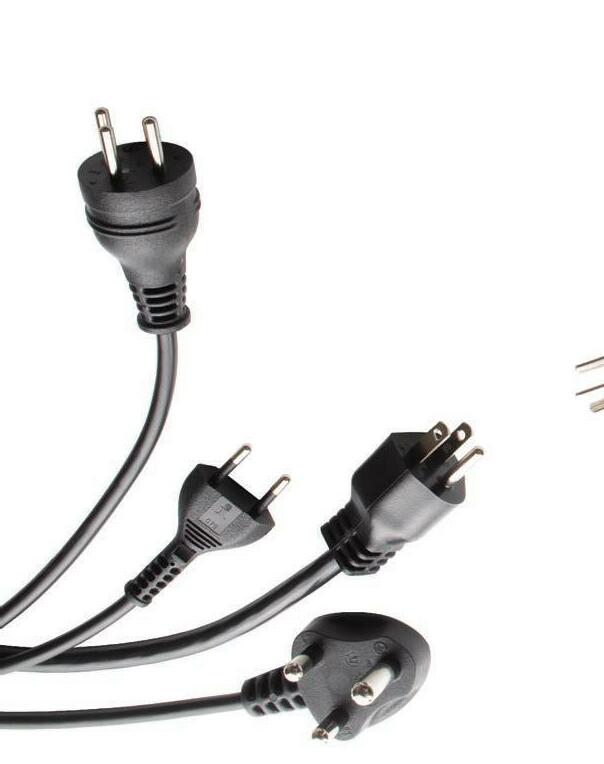
same
let your cords sit in dry-dock or a storage facility
Whether North American 5-15, 5-20, 6-15, or 6-20 cords, or international country-specific cords bearing country-specific plugs, IEC connectors terminate the other end to make cord sets ready to use right out of the box! Amperage, gauge, length, color, labeling and packaging—these preferences are up to you.Whether your cords are hanked, coiled, bundled, labeled, barcoded or bagged, our cords are ready to use right out of the box.
Made in the U.S.A., Interpower cords, cord sets, and components are tested and retested until surpassing agency standards. “We test more than the standards require for our own benefit,” Interpower Product Development Manager, Ron Barnett said. “We do so because it lends better reliability to our design.”

Why let your cords sit in dry-dock?
INTERPOWER | P.O. Box 115 | 100 Interpower Ave | Oskaloosa, IA 52577 | Toll-Free Phone: (800) 662-2290 | Toll-Free Fax: (800) 645-5360 | info@interpower.com Order Online! www.interpower.com ® ® Business Hours: 7 a.m.–6 p.m. CST
• World-class customer service 7 a.m. to 6 p.m. CST • Value-added options and made-to-order assemblies • No minimum orders • Blanket and scheduled orders available Interpower
the
day! Why
waiting for transportation?








































